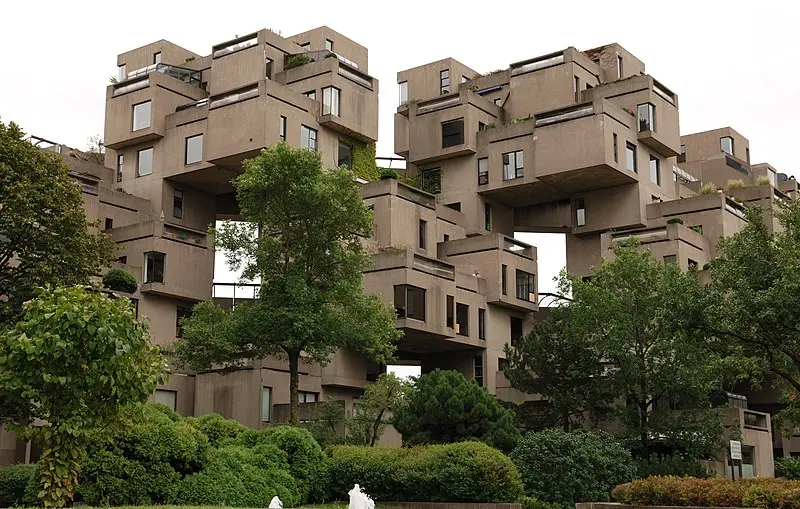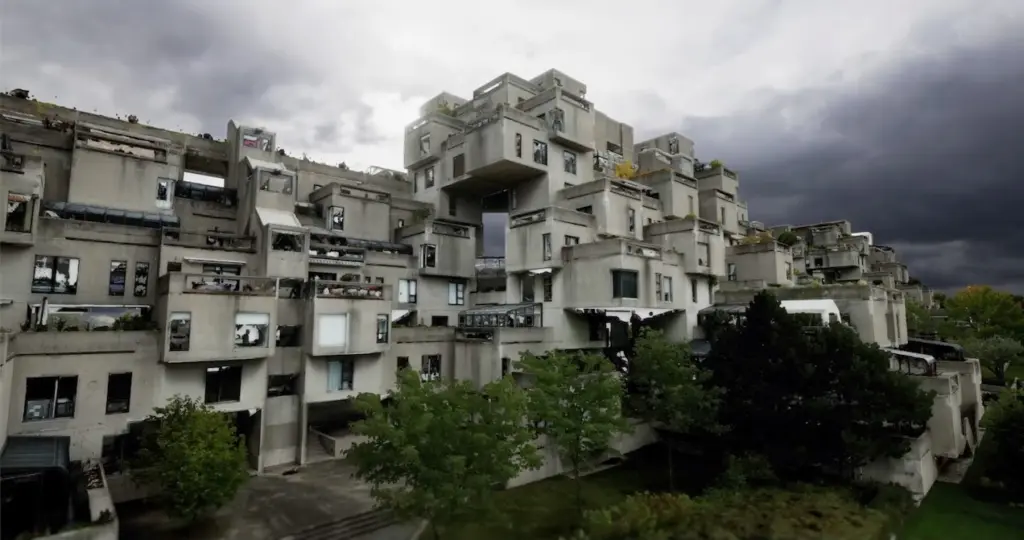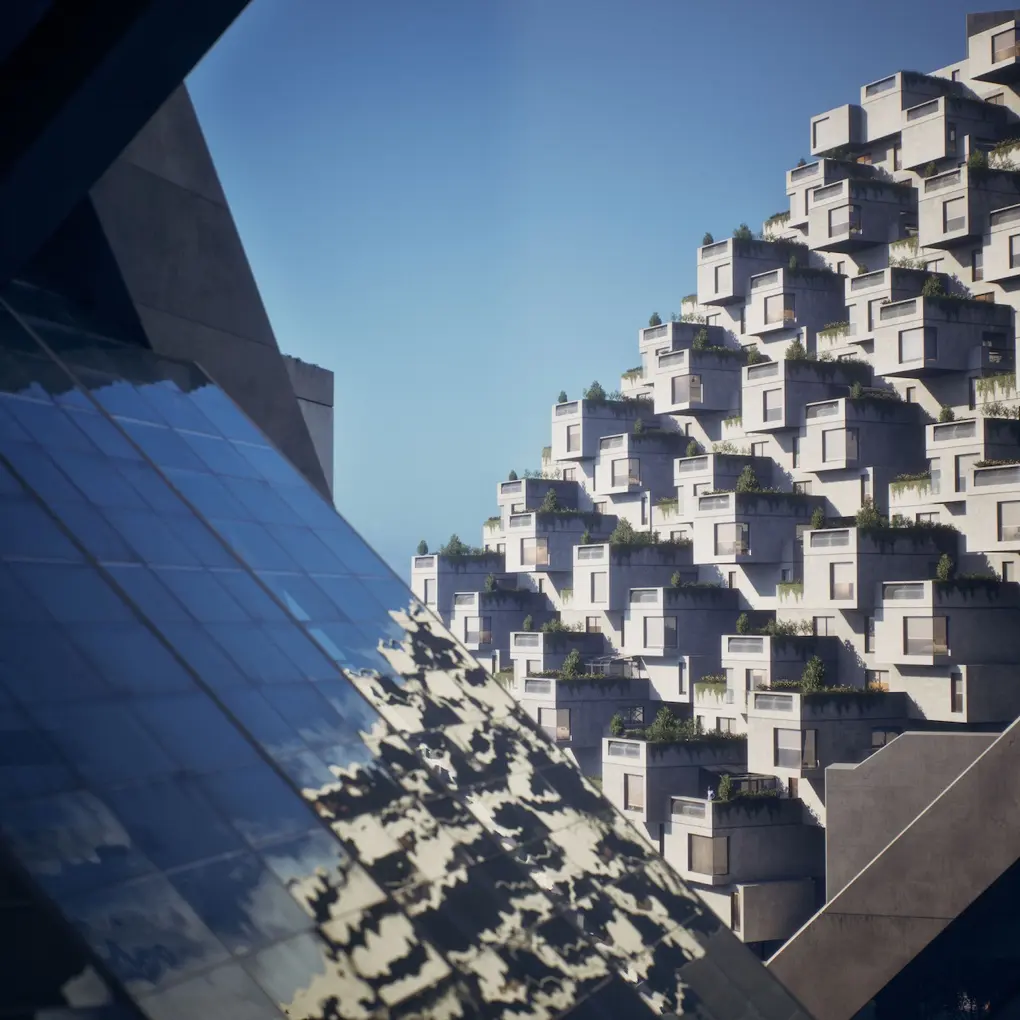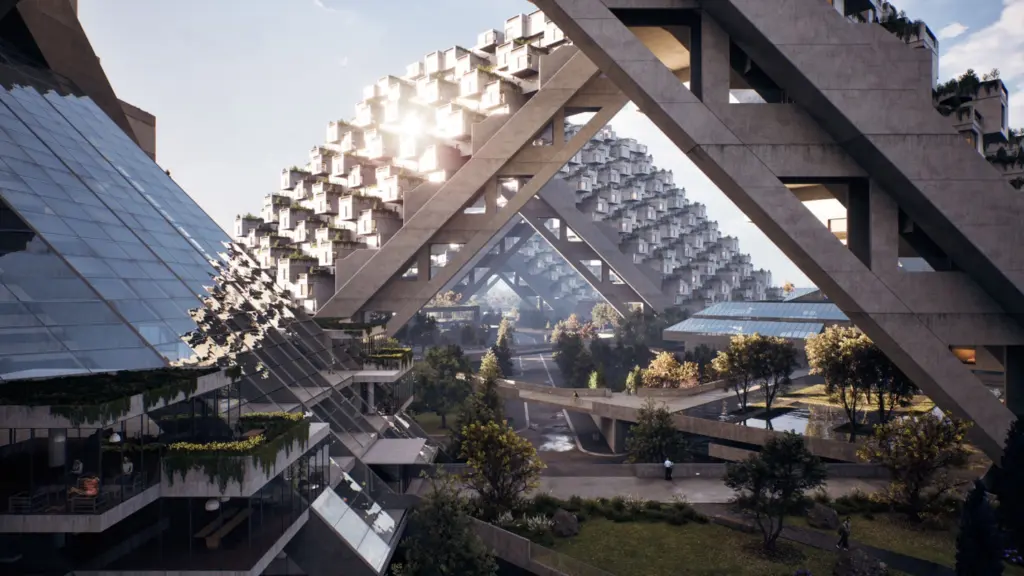
A young architect’s design for a large-scale mixed-use development was so impressive and unique that it was accepted, built, and featured at Expo 67, the 1967 World’s Fair in Montreal. However, due to a limited budget, the massive project was reduced significantly, and only a small portion of just the apartments were constructed. Nevertheless, decades later, the design is celebrated and studied worldwide. As a technological challenge, Epic Games teamed up with architectural visualization experts Neoscape and that young visionary’s renowned architectural firm to virtually construct the development in its entirety so it can be explored in real time.
Some people dream big. Moshe Safdie is, and always has been, one of those people.
In the early 1960s, Safdie was a budding young architect with a housing design concept that he created for his master’s thesis in architecture at McGill University in Montreal. Following graduation, he took a job in Philadelphia and was soon prompted by his former thesis advisor to further develop his thesis design and submit it for consideration as a permanent mixed-use community development design for the Expo 67, a world’s fair that would take place in Montreal. The fair committee was so taken with his unique modular concept that Safdie’s modular housing complex was featured alongside approximately 90 other (albeit temporary) pavilions centered on the theme Man and His World.
Today, Safdie’s structure is the only intact pavilion that remains.

The original design entailed multistory structures along with streets, gardens, shops, office and commercial space, and more, a city unto itself, all built around the concepts of community and open space within a dense, urban area. Due to costs, the project was greatly scaled back to include a small number of the proposed housing units only, but their design sensibility remained. According to the plan, interlocking prefabricated concrete forms would be arranged in various combinations, and each apartment would have a private landscaped terrace built atop the roof of the unit below. Although the development sits on a smaller slice of the Cité-du-Havre peninsula, with a view of Montreal, it remains a dream, really, for suburban residents.
Called Habitat 67, the project was ahead of its time. It was one of the first to introduce the mixed-use concept, incorporating office spaces, hotels, schools, museums, and more, along with the residential space. In essence, it brought the suburbs to an urban area. Originally, the design called for 1,200 homes at a cost of Can$45 million but was downsized to just 158 apartments when funding for the full community could not be secured.
In its smaller form, Habitat 67 is made from 354 identical prefab forms arranged in various combinations and divided into three pyramids, for a total of 12 residential stories along with a parking level and building services level. Even in its diminished size, Habitat 67 is something to behold. The units are coveted by the tenants living in this urban oasis, and today the building is considered an architectural landmark, situated along the banks of the St. Lawrence River.

And let’s not forget, even in its reduced form, this was the grand vision of a young, 23-year-old architect. But what would the area have been like if the project had been constructed in its entirety? Fast-forward a number of decades, and today, Safdie is a highly respected architect and urban planner, having designed countless major projects during his lengthy career. Still, he and many others in the architectural community have always wondered what the completed vision would have been like. Now they no longer have to wonder; they can see it for themselves.
Recently, creative agency Neoscape worked with Safdie Architects to create a 3D virtual rendition of the full project as Safdie had envisioned it six decades ago. Using Epic’s Unreal Engine 5, the group set out to explore the design implications of the larger build, whether there were any unforeseen issues, whether the design overwhelmed the space, and to finally “see” that vision come to life, if only virtual.
Architectural evolution
When Safdie drew up the original plans back in the 1960s, the design process was quite different than it is today, with most architects using 3D modeling software. As Jaron Lubin, senior partner at Safdie Architects, points out, the original Habitat project was designed by Safdie and his team without the use of computers. “He recalls the story that his structural engineer, August Komendant, had made all the load path calculations using a slide rule. And to solve the intense geometric interfaces, the team made many physical [scale] models,” Lubin says.

That process, which was laborious, was not exactly well suited for the type of design Safdie was trying to achieve. To make the process faster and easier, Safdie turned to an unlikely tool—a toy. “Lego was a new product in Canada then, and they bought up all the Legos in Montreal at the time,“ says Lubin.
Adds Safdie, “Lego was modular. [The bricks] could be stacked and shifted in increments. It was working with that system that I designed Habitat.”
Today, the architectural firm continues to work with physical models but depends a lot more on the use of 3D modeling software as well. “Our clients like to see the entire design in rich detail before they approve the work. In the past, the architect provided a crude model and some hand sketches. Now, we make photorealistic renderings and films, VR walk-throughs, and interactive pieces to convey the spaces before they are realized,” Lubin says.
The architectural industry has evolved with new tools and techniques currently in use that were unfathomable when this project originated. Unreal Engine is among them. “When Epic Games came to us with the challenge of bringing the complete Habitat 67 to life, we were super excited. It’s a project that was so important to the architectural world,” says Ryan Cohen, partner at Neoscape, which has worked with Safdie Architects for many years now creating interactive architectural visualizations.
The initial goal of this re-creation was to put Unreal Engine to the test and showcase the functionality of the popular game engine in the architectural visualization realm, using a real-world project of mega proportions to push its limits. To this end, Neoscape, which historically uses more traditional animation tools such as Chaos’ V-Ray to bring architectural designs to life, concentrated its efforts instead on using Unreal Engine, which ran on the office’s Lenovo workstations. Throughout the project, Epic was determined to have Neoscape use the available Unreal Engine tools with as little customization as possible, to show what can be accomplished with the software.
Rather than showcasing the capabilities of Unreal Engine on a fictitious project, Epic and Neoscape agreed that an actual project that would push the tools to their limit would have greater impact. “Epic really wanted to see if a studio like ours could find value in [Unreal] and show the rest of the architectural, engineering, and architectural visualization worlds that something like this is possible with Unreal and that it has a lot of value in this industry,” says Cohen.
Neoscape still does a lot of its work using traditional animation tools, having found real-time solutions limiting in regard to image quality. “Now, however, Unreal 5.2 has basically merged the artistry with the kind of hardware and software that can support that artistry,” Cohen adds.
The virtual construction process
The virtual build-out of the full project is called Project Hillside, so named for Safdie’s design change from modules stacked 30 stories high in a frame-like tower to one that had them leaning back, as if on a hillside, which allowed for each apartment to have a garden and areas that were open skyward.
Before that work could begin, the current structure had to be digitally mapped. This was done by flying a drone equipped with a camera and Lidar in a preprogrammed path around the building. Another drone, meanwhile, captured high-resolution images, 4,136 in all, to obtain structural details inside the perimeter. The files were then combined and processed by Neoscape using RealityCapture photogrammetry software from Capturing Reality, resulting in an accurate and detailed model of Habitat 67 that served as a starting point. The model would also be usable for future studies.

Back in the 1960s, Safdie designed the full project as a pitch, and when it was reduced in size, the associated construction documents only pertained to the scaled-down version. So, certain elements had to be considered more carefully now.
Using the original schematic drawings, which, along with scale models, are archived at McGill University, a team from Safdie Architects and Neoscape further developed and fleshed out the initial concept with tremendous detail so they could generate a 3D model—essentially making it “real.” However, as is typical, the 3D model requires a good deal of cleanup and translation so it can be used in Unreal Engine. It has to contain all the materiality, architectural details, and so on, but also has to function efficiently in real time. Whereas in the past, Neoscape would have sent those files, often with billions of polygons, sent to a render farm; now the rendering occurs on the fly. “So we had to take that file and make it more efficient, without losing any of the details or architectural information,” he says.
According to Neoscape, they had to pay particular attention to how the buildings would be assembled, connected to the parking, how the water features and gardens would be laid out and function, where the pedestrian and vehicle connections would be placed, and so on.
Next, Safdie Architects began designing the full community with the hotel, school, office spaces, and other structures that were part of Safdie’s initial vision. The 3D model was built in Robert McNeel & Associates’ Rhino CAD software and Autodesk’s 3ds Max, and later was imported into Unreal Engine 5 using the Datasmith importer plug-in. Once inside Unreal, the set was dressed with trees, plants, etc. The team also used the Sun and Sky plug-in, along with a custom volumetric cloud shader and atmospheric height fog that could be easily adjusted without requiring programming or game development experience.
Neoscape did not just build the complex, but also built the surrounding area to put it in context. The model, complete with a rendition of Montreal across the river, comprises 4.5 billion triangles. To make the huge model easier to work with, Neoscape adopted the same modular construction technique for the virtual structure as the real-world one, developing a tool that converted Rhino groups and blocks into static meshes, which are automatically placed in the correct location.
The company also used the Nanite micropolygonal system within Unreal to maintain fidelity without a drop in performance. Lumen, a fully dynamic global illumination solution, was also used. Because rendering was occurring at such a fast pace and in real time, art direction and decisions could be made to the model early on during live review sessions.
For Neoscape, the biggest challenge was the scale of the project and its fidelity, in addition to altering its then workflow to use Unreal Engine for most of the work—and beta-testing version 5. “We were with Epic on a lot of the tools that were being created for this version, to test how Unreal could support architectural visualization. That’s one of the reasons we wanted to have a choice among a hundred different lighting scenarios and weather conditions [in the real-time visualization], to make sure the program worked,” says Cohen.

A design for then and now
Project Hillside, which took about a year, is now digitally complete. Perhaps if the group would have had the visualization tools available today, as opposed to drawings and scale models, they may have had a better chance of getting the entire project approved, as the city would have been able to truly understand the impact of the design, says Cohen. Also, Safdie would have been able to illustrate the emotional impact of the project—and what it feels like being there in the space.
Looking at the virtual build, one can see that the design still holds up today, and that it is just as relevant now as it was in the 1960s, or maybe even more so in light of the present-day housing crisis, especially in urban communities.

And maybe, just maybe, the project in its entirety could one day see the light of day somewhere. “We look at the Hillside models and are really excited to find the right place to build them,” says Lubin. “The design is a total prefabricated system, so we expect that we would also be working with an industry partner, yet to be identified. Looking ahead, this design has the potential to change the way we build today.”
So, could Hillside be built today as it was originally envisioned? “Absolutely,” says Lubin. “The technology exists, as is the need and desire for this type of quality housing. We like to say that after almost 60 years, the time has come for this project to be realized.”
Back in the ‘60s, Safdie’s design garnered skepticism and controversy among traditionalists who insisted the unique configuration would collapse. It didn’t and still stands today. Not only that, the structure—which was later purchased by individuals—became a cultural landmark, an architectural landmark, an inspiration to many architects, and the subject of architectural studies for years after. Whether you are an architect, student, budding filmmaker, or just curious, the Hillside Sample Project is available to explore on the Unreal Engine website.






